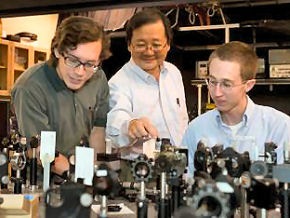5 July 2010
Super-high pressures used to create super "battery"
by Kate Melville
 Using pressures similar to those found deep in the Earth, researchers from Washington State University have created a compact, never-before-seen material that lead researcher Choong-Shik Yoo (pictured center) says is the most condensed form of energy storage outside of nuclear energy.
Using pressures similar to those found deep in the Earth, researchers from Washington State University have created a compact, never-before-seen material that lead researcher Choong-Shik Yoo (pictured center) says is the most condensed form of energy storage outside of nuclear energy.
The researchers created the material in a diamond anvil cell, a small, two-inch by three-inch-diameter device capable of producing extremely high pressures in a small space. The cell contained xenon difluoride (XeF2), a white crystal used to etch silicon conductors, squeezed between two small diamond anvils.
At normal atmospheric pressure, the material's molecules stay relatively far apart from each other. But as the pressure inside the chamber is increased, the material becomes a two-dimensional graphite-like semiconductor.
Yoo eventually increased the pressure to more than a million atmospheres, comparable to what would be found halfway to the center of the Earth. The squeezing forced the molecules to make tightly bound three-dimensional metallic network structures. In the process, the huge amount of mechanical energy of compression was stored as chemical energy in the molecules' bonds.
The research, published in Nature Chemistry, shows that strong chemical bonds can store vast amounts of mechanical energy. Possible future applications include creating a new class of energetic materials or fuels, energy storage devices, super-oxidizing materials for destroying chemical and biological agents, and high-temperature superconductors.
Related:
Battery built from GM viruses
"Spin battery" provides novel electrical storage
Atom Wrangling Gets Serious
Source: Washington State University
